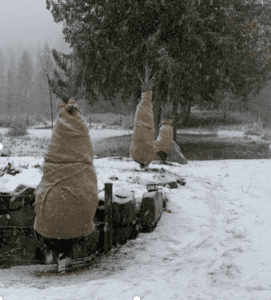
Start from the ground up
Carefully loosen compacted soil with garden forks or hand tools to increase its capacity for drainage once the snow piles up. This prevents the roots of your tree or shrub from being suffocated.
Next, consider fertilizing trees and shrubs that don’t grow in nutrient-rich soil. Be sure to use a fertilizer specifically tailored to your tree and soils. For example, if it’s one that you’ve recently planted, steer clear of using fertilizer with too much nitrogen since it can do more harm than good. When you go to buy your soil at a home and garden store, speak to an associate for an idea of what type of soil your trees and shrubs need.
Insulation helps
After aerating and fertilizing the soil, turn your attention to blanketing the root system for the winter season. Insulating your tree or shrub’s root system is crucial to ensuring their protection from the cold.
To winterize your trees’ and shrubs’ root systems, spread a hefty 4” layer of mulch on the ground as far as the tree’s branches spread. Not only does this create a warm and cosy winter blanket, but it also helps prevent weeds from taking root in early spring. Just make sure that the mulch doesn’t touch or pile up against the tree trunk itself or else you may create a prolonged ice block around the tree and create perfect habitat for unwanted fungi. Aim for an even layer all around.
Love the Branches and the Bark
Just like you cut back your flower beds before the freeze arrives, you’ll also want to prune dead and damaged branches that could harm your trees during the winter. Completely remove any branches that clearly are dead or rotting—these provide food and shelter for unwanted pests, they are also the most prone to break under snow load and damage the further damage the tree. Next, lightly trim branches that will touch the ground under the weight of heavy snow. Branches that sit on the ground are far more likely to pick up moisture rot and disease.
Be mindful while you prune; you want to preserve and protect as many of the healthy branches as possible. If you absolutely must make a cut, make sure you’re using a sharp, clean pair of shears. Clip the branch above and below the branch collar (the slightly bulbous area where the branch meets the tree trunk) instead of trying to remove the branch in one cut. Visit us on our next Pruning Seminar for greater in depth details.
Yes you should water
Just like the other flora in your landscape, your trees need to stay hydrated to take in nutrients from the soil and keep their root systems healthy.
When winter arrives, frozen soil prevents your plants from drinking in the water they need and if the soil is not moist, the winter winds can further “dry” the soils and freeze dry your roots. Giving your trees and shrubs a few deep watering sessions prior to the first hard freeze will help them store up that crucial well of hydration. We recommend the “5+5 rule” for winterizing newly planted trees: five gallons of water as a base, plus another five gallons for every inch of your trunk’s diameter.
Wrap vulnerable columnar trees & shrubs
Winterize sensitive trees and shrubs by wrapping them in burlap before the first snow. This protects them from a variety of ailments including winter burn, characterised by patches of brown, dry, brittle needles on the sides of your evergreens. Young trees are especially vulnerable to both winter burn and sun scald, which damages the trunk in places where the tree’s heartwood is exposed to the freezing temperatures.
Especially if you have columnar evergreens and shrubs, should be wrapped in burlap to protect the needles from collecting ice, wind burn, heavy snow and sun, but avoid wrapping the very top as excess burlap will itself collect snow and ice and begin to bend and weigh down the tree from the tip.
Wrap the trunks of smooth bark trees, as well as those that are young or freshly planted with protective spirals or other such materials. Spirals protect young trees from having their bark eaten by rodents during winter, which may easily kill them. Tree protection is more important for some trees than for others, as not all trees are attractive to rodents (although they will probably eat almost anything if there is no other choice and they are very hungry). Those that rodents do seem to find particularly tasty include most types of fruit trees, with the exception of grapevines. Rodent protection is particularly important for grafted trees, as if the bark is eaten below the graft of the tree, the cultivar will be lost.
